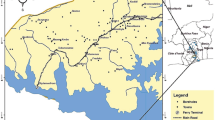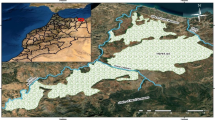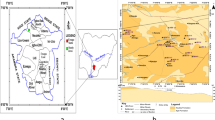Abstract
Over the past 3 decades, Iran’s groundwater reservoirs have faced a significant and interconnected challenge. Simultaneous declines in volume and purity, exacerbated by escalating pollutants due to heavy reliance, underscore the imperative for a comprehensive assessment of groundwater quality and vulnerability, utilizing indicators and models. This research introduces an innovative integrated framework, merging vulnerability assessment with pollutant flow path analysis, for a comprehensive evaluation of groundwater pollution in the Zanjanrud River Basin. Robust vulnerability assessment methods, DRASTIC and HPI, were used to evaluate intrinsic and specific vulnerability. The MODFLOW model underwent meticulous three-year calibration to quantify aquifer dynamics, while the MODPATH numerical model simulated pollutant transport. The DRASTIC Index identifies approximately 45.4% of the study area as having low vulnerability, while the HPI reports a mean value of 30.3, indicating medium vulnerability. These collective results classify the aquifer as medium–low risk. Key DRASTIC parameters, such as hydraulic conductivity, aquifer environment, and soil characteristics, significantly influence vulnerability assessment. Furthermore, HPI trends consistently decrease in vulnerability downstream, underscoring the impact of natural processes and self-remediation mechanisms in mitigating heavy metal concentrations. Numerical modeling reveals pollutants can travel up to one kilometer within three years in the alluvial region, with central wells displaying longer barrier lengths compared to peripheral ones. This study provides crucial insights into groundwater vulnerability, pollutant flow, and management strategies, offering valuable guidance for enhancing groundwater quality in similar regions.







Similar content being viewed by others
Availability of data and material
The data produced and/or analyzed during the present investigation can be obtained from the corresponding author upon reasonable inquiry.
References
Abdollahi Z, Kavian A, Sadeghi SH, Khosrovyan A, DelValls A (2019) Identifying environmental risk associated with anthropogenic activities in Zanjanrud River, Iran, using an integrated approach. CATENA. https://doi.org/10.1016/j.catena.2019.104156
Ahmed S, Akhtar N, Rahman A, Mondal NC, Khurshid S, Sarah S, Khan MMA, Kamboj V (2022a) Evaluating groundwater pollution with emphasizing heavy metal hotspots in an urbanized alluvium watershed of Yamuna River, northern India. Environ Nanotechnol Monit Manag 18:1007442. https://doi.org/10.1016/j.enmm.2022.100744. (ISSN 2215-1532)
Ahmed SI, Cheng CL, Gonzalez J, Kang JJ, Ho J, Soto-Sanchez L (2022b) Groundwater vulnerability assessment of shallow aquifer in the South Texas sand sheet using a GIS-based DRASTIC model. Earth Syst Environ 8:4075–4091. https://doi.org/10.1007/s40808-021-01292-4
Aller L, Bennett T, Lehr JH, Petty RJ, Hackett G (1987) DRASTIC: a standardized system for evaluating ground water pollution potential using hydrogeologic settings. J Geol Soc India 29(1):41–45
Almasri MN, Kaluarachchi JJ (2007) Modeling nitrate contamination of groundwater in agricultural watersheds. J Hydrol 343:211–229. https://doi.org/10.1016/j.jhydrol.2007.06.016
Arya S, Subramani T, Vennila G, Roy PD (2020) Groundwater vulnerability to pollution in the semi-arid Vattamalaikarai River Basin of south India thorough DRASTIC index evaluation. Geochemistry 80:25635. https://doi.org/10.1016/j.chemer.2020.125635
Asomaku SO (2023) Quality assessment of groundwater sourced from nearby abandoned landfills from Industrial City in Nigeria: water pollution indices approach. Hydroresearch 6:130–137. https://doi.org/10.1016/j.hydres.2023.03.002
Bailey RT, Jeong J, Park S, Green CHM (2022) Simulating salinity transport in high-desert landscapes using APEX-MODFLOW-Salt. J Hydrol 610:127873. https://doi.org/10.1016/j.jhydrol.2022.127873
Balakrishnan A, Ramu A (2016) Evaluation of heavy metal pollution index (HPI) of ground water in and around the coastal area of Gulf of Mannar Biosphere and Palk Strait. J Adv Chem Sci 2(3):331–333
Breabăn IG, Paiu M (2012) Application of DRASTIC model and GIS for evaluation of aquifer vulnerability: study case Barlad city area. Geosci J 22:843–855. https://doi.org/10.1007/s12303-017-0082-9
Bureau of Indian Standards (BIS) (2003). https://archive.org/details/gov.in.is.15339.2003/page/n5/mode/2up
Dehghanipour AH, Zahabiyoun B, Schoups G, Babazadeh H (2019) A WEAP-MODFLOW surface water-groundwater model for the irrigated Miyandoab plain, Urmia Lake basin, Iran: multi-objective calibration and quantification of historical drought impacts. Agric Water Manag 223:105704. https://doi.org/10.1016/j.agwat.2019.105704
Dey M, Akter A, Islam S, Dey SC, Choudhury TR, Fatema KJ, Begum BA (2021) Assessment of contamination level, pollution risk and source apportionment of heavy metals in the Halda River water, Bangladesh. Heliyon 7:e08625. https://doi.org/10.1016/j.heliyon.2021.e08625
Fioreze M, Mancuso MA (2019) MODFLOW and MODPATH for hydrodynamic simulation of porous media in horizontal subsurface flow constructed wetlands: a tool for design criteria. J Ecol Eng 130:45–52. https://doi.org/10.1016/j.ecoleng.2019.01.012
Ganapathi H, Vasudevan P (2021) Assessment of groundwater vulnerability to pollution in Chennai metropolis using DRASTIC and GIS. e-J Geohydrol 2(1):41–48
Guo X, Xiong H, Li H, Gui X, Hu X, Li Y, Cui H, Qiu Y, Zhang F, Ma C (2023) Designing dynamic groundwater management strategies through a composite groundwater vulnerability model: Integrating human-related parameters into the DRASTIC model using LightGBM regression and SHAP analysis. Environ Res 236:116871. https://doi.org/10.1016/j.envres.2023.116871
Jareda G, Dhekne PY, Mahapatral SP (2016) Water quality index and heavy metal pollution index of Bailadila Iron ore mine area and its peripherals. Int J Eng Appl Sci 3(12):80–88
Kardan Moghaddam H, Jafari F, Javadi S (2017) Vulnerability evaluation of a coastal aquifer via GALDIT model and comparison with DRASTIC index using quality parameters. Hydrol Sci J 62(1):137–146. https://doi.org/10.1080/02626667.2015.1080827
Kardan Moghaddam H, Banihabib ME, Javadi S (2018) Quantitative sustainability analysis of aquifer system (case study: South Khorasan-Birjand aquifer). J Water Soil 31(6):Pe1587–Pe1601
Kaur N, Kaur S, Tsolakis N, Mishra N, Sra JS (2022) Managing groundwater demand through surface water and reuse strategies in an overexploited aquifer of Indian Punjab. Model Earth Syst Environ 9:2009–2026. https://doi.org/10.1007/s40808-022-01602-4
Kumar S, Toppo S, Kumar A et al (2020) Assessment of heavy metal pollution in groundwater of an industrial area: a case study from Ramgarh, Jharkhand, India. Int J Environ Analyt Chem. https://doi.org/10.1080/03067319.2020.1828391
Maqsoom A, Aslam B, Khalil U, Ghorbanzadeh O, Ashraf H, Faisal Tufail R, Farooq D, Blaschke T (2020) A GIS-based DRASTIC model and an adjusted DRASTIC model (DRASTICA) for groundwater susceptibility assessment along the China–Pakistan Economic Corridor (CPEC) route. ISPRS Int J Geoinf 9(5):332. https://doi.org/10.3390/ijgi9050332
McDonald MG, Harbaugh AW (1988) A modular three-dimensional finite-difference ground-water flow model. Tech Water-ResourInvestig. https://doi.org/10.3133/twri06A1
Mfonka Z, Ngoupayou JN, Ndjigui PD, Kpoumie A, Zammouri M, Ngouh AN, Mouncherou OF, Rakotondrabe F, Rasolomanana EH (2018) A GIS-based DRASTIC and GOD models for assessing alterites aquifer of three experimental watersheds in Foumban (Western–Cameroon). Groundw Sustain Dev 7:250–264. https://doi.org/10.1016/j.gsd.2018.06.006
Monatisa L, de Kock LA, Mamba BB, Nkambule TTI, Izady A, Al-Maktoumi A, Msagati TA (2023) Development of the early warning model for oil produced water pollution and compliance with the guidelines using dimensional analysis. J Water Process Eng 53:103870. https://doi.org/10.1016/j.jwpe.2023.103870
Nasrabadi T (2015) An index approach to metallic pollution in river waters. Int J Environ Res 9:385–394
Parizanganeh A, Hajisoltani P, Zamani A (2010) Assessment of heavy metal pollution in surficial soils surrounding Zinc Industrial Complex in Zanjan, Iran. Proc Environ Sci 2:162–166. https://doi.org/10.1016/j.proenv.2010.10.019
Pietrzak D (2021) Modeling migration of organic pollutants in groundwater—review of available software. Environ Model Softw 44:105145. https://doi.org/10.1016/j.envsoft.2021.105145
Rosen L (1994) A study of the DRASTIC methodology with emphasis on Swedish conditions. Groundwater 32:278–285. https://doi.org/10.1111/j.1745-6584.1994.tb00642.x
Shaabani MK, Abedi-Koupai J, Eslamian SS, Gohari A (2022) Simulation of the effects of climate change and reduced irrigation requirements on groundwater recharge using SWAT and MODFLOW models. Modelg Earth Syst Environ 9:1681–1693. https://doi.org/10.1007/s40808-022-01580-7
Singh PK, Verma P, Tiwari AK, Sharma S, Purty P (2015) Review of various contamination index approaches to evaluate groundwater quality with geographic information system (GIS). Int J ChemTech Res 7(4):1920–1929
Sundar ML, Ragunath S, Hemalatha J, Vivek S, Mohanraj M, Sampathkumar V, Ansari AMS, Parthiban V, Manoj S (2022) Simulation of groundwater quality for Noyyal River Basin of Coimbatore City, Tamil Nadu Using MODFLOW. Chemosphere 306:135649. https://doi.org/10.1016/j.chemosphere.2022.135649
Tiwari AK, De Maio M, Singh PK, Mahato MK (2015) Evaluation of surface water quality by using GIS and a heavy metal pollution index (HPI) model in a coal mining area, India. Bull Environ Contam Toxicol 95:304–310. https://doi.org/10.1007/s00128-015-1558-9
Vrba I, Zaporozec A (1994) Guidebook on mapping groundwater vulnerability. Int Contrib Hydrogeol 16:131
World Health Organization (2006) The world health report. https://www.who.int/publications/i/item/9241563176
Yan F, Li N, Wang J, Wu H (2023) Ecological footprint model of heavy metal pollution in water environment based on the potential ecological risk index. J Environ Manag 344:118708. https://doi.org/10.1016/j.jenvman.2023.118708
Yang Q, Lun W, Fang Y (2011) Numerical modeling of three-dimensional groundwater flow in Tongliao, China. Proc Eng 24:638–642. https://doi.org/10.1016/j.proeng.2011.11.2709
You X, Liu S, Esfahani SG, Duan Y, Li J, Dai C, Werth CJ (2023) Modeling EDTA-facilitated cadmium migration in high- and low-permeability systems using MODFLOW and RT3D. J Contam Hydrol 256:104171. https://doi.org/10.1016/j.jconhyd.2023.104171
Zghibi A, Merzougui A, Chenini I, Ergaieg K, Zouhri L, Tarhouni J (2016) Groundwater vulnerability analysis of Tunisian coastal aquifer: an application of DRASTIC index method in GIS environment. Groundw Sustain Dev 2:169–181. https://doi.org/10.1016/j.gsd.2016.10.001
Acknowledgements
We would like to express our gratitude to Mr. Farid Abbasi and Mahab Baresh consulting company for providing us with the necessary data for this research. We acknowledge their contribution to this work and appreciate their willingness to collaborate.
Funding
The study did not receive any dedicated funding from public, commercial, or non-profit organizations.
Author information
Authors and Affiliations
Contributions
Conceptualization: MA and NN; Methodology: PJ and Mohsen Yavari Nia; Formal analysis and investigation: FS and MYN; Writing—original draft preparation: AP and and HA; Writing—review and editing: MP; Resources: SA, Supervision: MJA.
Corresponding author
Ethics declarations
Conflict of interest
The authors state that they do not have any known financial interests or personal relationships that could have potentially influenced the findings presented in this manuscript.
Additional information
Publisher's Note
Springer Nature remains neutral with regard to jurisdictional claims in published maps and institutional affiliations.
Rights and permissions
Springer Nature or its licensor (e.g. a society or other partner) holds exclusive rights to this article under a publishing agreement with the author(s) or other rightsholder(s); author self-archiving of the accepted manuscript version of this article is solely governed by the terms of such publishing agreement and applicable law.
About this article
Cite this article
Nejatian, N., abbaspour, M., Javidan, P. et al. Evaluation of the vulnerability and pathways of groundwater pollution in the Zanjanrud river basin by an integrated modeling approach. Model. Earth Syst. Environ. 10, 2295–2308 (2024). https://doi.org/10.1007/s40808-023-01897-x
Received:
Accepted:
Published:
Issue Date:
DOI: https://doi.org/10.1007/s40808-023-01897-x




